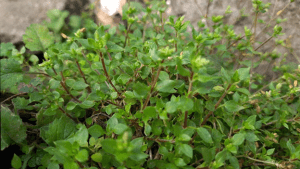TAG: GS 3: ECOLOGY AND ENVIRONMENT
THE CONTEXT: A new plant species has been discovered on the high, muddy slopes of the Nelliyampathy hills in Kerala’s Palakkad district.
EXPLANATION:
- This species, belonging to the genus Stellaria and named Stellaria mcclintockiae.
- It was named after the American scientist Barbara McClintock, who was awarded the 1983 Nobel Prize in Physiology or Medicine for her discovery of mobile genetic elements, commonly known as ‘jumping genes.’
Stellaria mcclintockiae:
- The new species belongs to the genus Stellaria (family Caryophyllaceae)
- The plant is an annual herb that grows up to 15 cm in height.
- Stellaria mcclintockiae exhibits several distinctive features that set it apart from other species in the genus Stellaria:
- Petals: The structure and morphology of the petals are unique.
- Pollen Morphology: The pollen grains of Stellaria mcclintockiae show specific traits that differ from related species.
- Bracts and Sepals: The shape and characteristics of the bracts and sepals are distinct.
- Seed Architecture: The seeds possess a unique architecture, contributing to the plant’s differentiation from other Stellaria species.
- It is currently known to exist only in the Nelliyampathy hills, at elevations between 1,250 and 1,400 meters.
- The naming of Stellaria mcclintockiae pays tribute to Barbara McClintock’s groundbreaking work in cytogenetics, particularly her research on maize that revealed the dynamic nature of genetic elements.
- Researchers identified this new species during the monsoon season of 2022.

Stellaria mcclintockiae
Challenges in Identification
- The genus Stellaria poses significant challenges for researchers due to the minute size of the floral parts and the subtle differences that delineate species.
- These traits make it difficult to identify and classify new species accurately.
- The identification of Stellaria mcclintockiae involved meticulous observation and genetic analysis to confirm its status as a new species.
Conservation Status
- The researchers have recommended that Stellaria mcclintockiae be classified as critically endangered under the criteria set by the International Union for Conservation of Nature (IUCN).
- The species’ population is very limited, and its habitat is threatened by severe grazing and trampling by elephants, which pose significant risks to its survival.
Significance of the Discovery
- The discovery of Stellaria mcclintockiae is significant for several reasons:
- Biodiversity: It enriches our understanding of the biodiversity in the Nelliyampathy hills and adds a new species to the flora of south India.
- Scientific Research: The identification process underscores the importance of genetic analysis and detailed morphological studies in classifying plant species.
- Conservation: Highlighting the critical status of this species emphasizes the need for conservation efforts to protect its habitat and ensure its survival.

